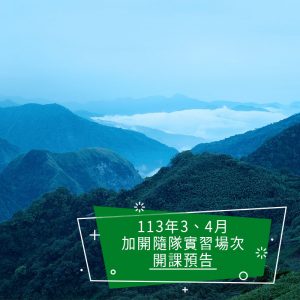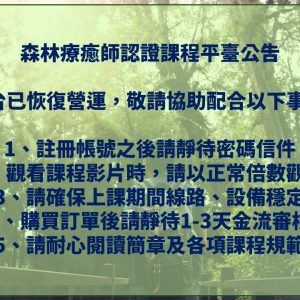- 2023.11.23
- 碩士論文
森林療癒對高齡族群生心理健康與認知功能效益
森林療癒對高齡族群生心理健康與認知功能效益
Effects of the Forest Therapy on Physiological, Psychological and Cognitive Health in the Elderly
作者:
曹辰Chen Tsao
來源
臺灣大學森林環境暨資源學研究所學位碩士論文
摘要:
隨著現代醫療技術進步、平均壽命延長以及生育率下降,臺灣老年人口比率逐漸增加,即將於2025年邁入超高齡社會。老化不僅要面對生理上身體機能衰退與認知功能下降,心理上情緒調適以及社交參與的改變都會造成老年人的壓力,亦提高老年憂鬱症的可能性。有鑒於森林療癒對於人體之效益,國內外研究指出森林療癒有助於提升生理健康與心理健康,對於認知功能改善之相關研究有限。本研究以臺灣大學實驗林溪頭自然教育園區作為試驗場域,共招募38位高齡者(平均年齡70.71歲)進行一周森林療癒研究,並以生理、心理以及認知功能指標評估其健康效益,研究目的為探討森林療癒對高齡族群之生理、心理以及認知功能之效益。
本研究採用單組前後測設計。生理指標採用心跳速率、血壓、以及心跳變異率;心理指標採用正負向情感量表、簡短型老人憂鬱量表與反芻反應風格量表;認知指標則採用順逆序數字測驗(工作記憶)、史楚普叫色測驗量測(注意力控制)以及中文詞彙遠距聯想測驗(創造力),並透過簡易智能評估量表以及參與者背景資料作為參考依據;參與程度透過參與次數以及GPS紀錄器所提供之參與者行走時間、距離資料進行分析。研究分析採用敘述性統計、成對樣本T檢定以及皮爾森積差相關係數。
研究結果顯示,在生理指標方面,森林療癒前後心跳速率具有顯著上升、副交感神經活性顯著下降之結果,交感神經活動及血壓無顯著差異。對於不同血壓初始值的參與者而言,森林療癒有助於調節血壓至正常範圍;在心理指標方面,簡短型老人憂鬱量表、正負面情緒量表及反芻反應風格量表三種心理量表皆顯示森林療癒前後,參與者之憂鬱症狀、正負面情緒與反芻無顯著差異;在認知指標方面,順逆序數字測驗、史楚普叫色測驗及中文詞彙遠距聯想測驗三種認知量表皆具有顯著差異;參與程度方面,森林療癒參與程度(次數、累積時間、距離)與生理、心理以及認知功能變化量無顯著相關。整體而言,本研究結果證實森林療癒有助於高齡族群血壓調節,亦可提升工作記憶、注意力控制與遠距聯想創造力等認知功能。
With the advancement of modern medical technology, the prolongation of average lifespan, and the decline of the fertility rate, the ratio of the elderly population in Taiwan is rapidly increasing, and it is about to enter a super-aged society in 2025. Aging not only faces a decline in physical function and cognitive ability but also changes in psychological stability and social interaction, which lead to stress and increase the risk of geriatric depression in the elderly. The benefits of forest therapy have been considered to contribute to human health worldwide, primarily physiological and psychological effects. Unfortunately, relevant research in cognitive health is limited. The present study investigated psychophysiological and cognitive health benefits changes after a 7-day forest therapy program in the Xitou Nature Education Area, Taiwan. Thirty-eight elderly participants (70.7 years on average) have joined the program. This study aims to investigate the effect of forest therapy in terms of psychophysiological and cognitive for the elderly.
The research design adopted a single-group pretest and posttest. The measurements included physiological responses (pulse rate, blood pressure, and rulse rate variability); psychological indices (Positive and Negative Affective Scale, 15-item geriatric depression scale, and Rumination Response Style Scale); cognitive measurement of working memory (Digit Span), attention control (Stroop Color and Word Test ) and creativity (Chinese Word Remote Associatives Test, CWRAT). Also, the background information and Mini-Mental Status Examination were measured to investigate individual differences’ influence. The level of participation is measured by the number of visits, accumulated time, and distance collected by the GPS receivers. The descriptive statistics, paired samples t-test, and Pearson’s rank correlation coefficient were used to analyze the results.
The results showed that the pulse rate is significantly higher and the parasympathetic nervous system is significantly lower after the program. The sympathetic nervous system and blood pressure have no significant difference. Here, we show that the effect of forest therapy can differ depending on a subject’s initial values and that forests have a blood pressure adjustment effect close to an appropriate level. The results showed that the psychological indices’ changes were insignificant. This study found that the cognitive benefits of forest therapy were significant differences, such as working memory (Digit Span), attention control (Stroop), and creativity (CWRAT) increased after the program. The number of visits, accumulated time, and distance had no significant correlation with physiological, psychological, and cognitive functions. In general, this study determined that forest therapy is a promising therapeutic method for enhancing cognitive health benefits and is effective for elderly individuals.
本網站僅整理臺灣森林療癒之期刊文章、論文、計畫報告摘要供參考
若需閱讀全文請逕至來源、主管機關索取資料


- Copyright © Forestry and Nature Conservation Angency
- 農業部林業及自然保育署 版權所有
- 電話:(02)2351-5441
- 地址:10050臺北市中正區杭州南路一段2號

- 台灣森林保健學會
- E-mail: twforesthealing@gmail.com
- 電話:(02)3366-4637
- 地址:10617台北市大安區羅斯福路四段1號 森林系館3F
- FB 台灣森林保健學會
Copyright © 2019 All Rights Reserved.





